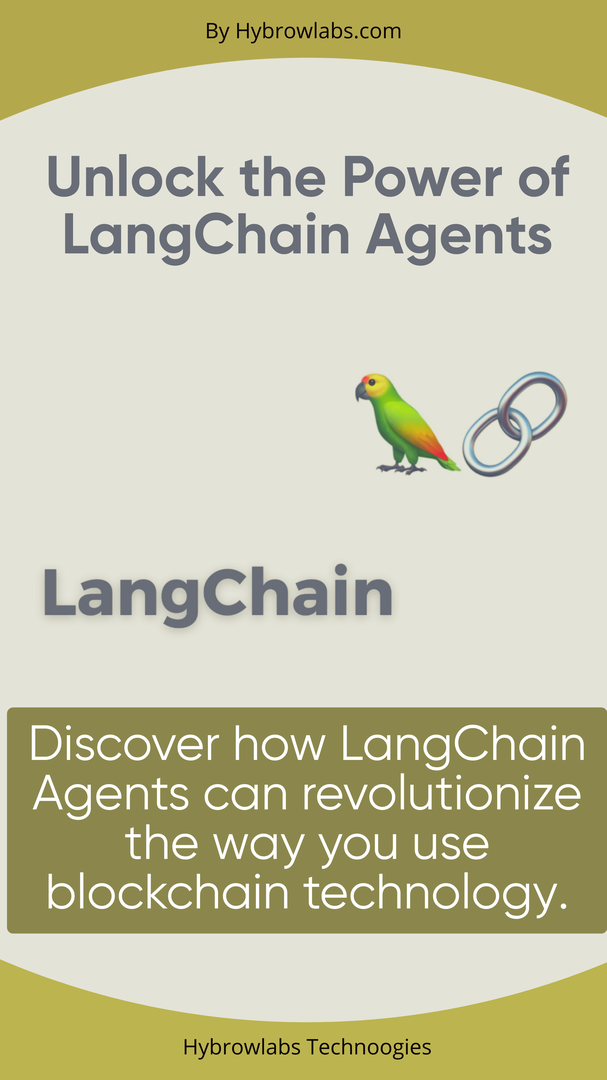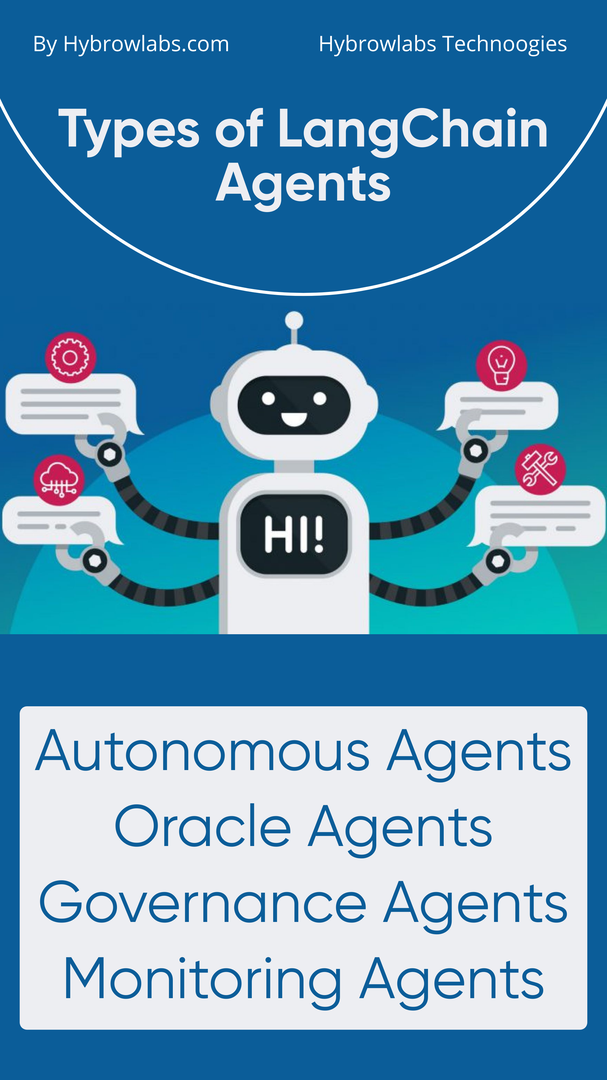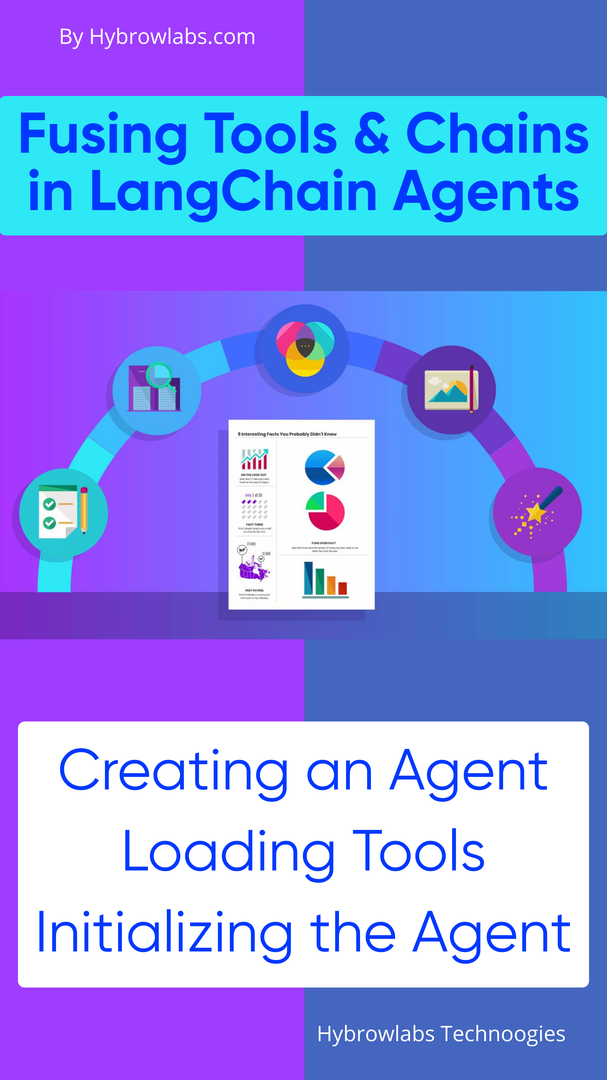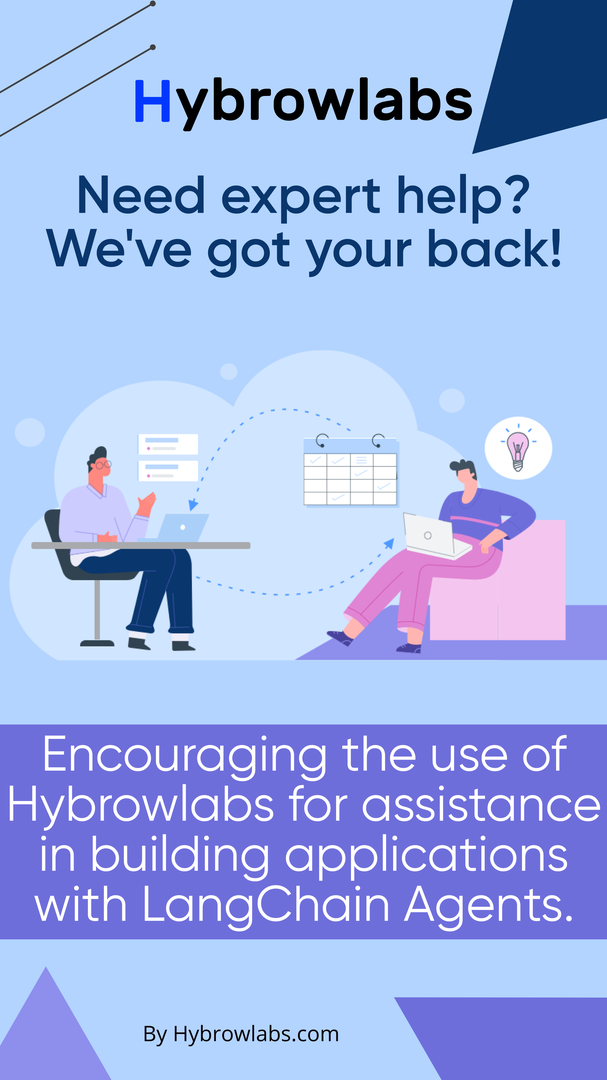
Blockchain technology has revolutionized the way we think about trust & transparency in digital transactions. The ability to create decentralized applications on the blockchain has opened up a whole new world of possibilities, from creating secure & transparent voting systems to managing supply chains in real-time.
In this article, we will explore the unmatched potential of LangChain Agents & how they can be used to join tools & chains with decisions. We will discuss the different types of LangChain Agents & their unique characteristics, & provide examples of how Agents can be used to create complex & sophisticated systems on the blockchain.
What are chains in LangChain?

In LangChain, a chain is a sequence of operations that can be executed atomically on the blockchain. These operations are called transactions, & they are used to update the state of the blockchain. For example, if you wanted to transfer some cryptocurrency from one account to another, you would create a transaction that deducts the amount from one account & adds it to the other.
Here is an example of a simple transaction in LangChain:
transaction Transfer(from: Address, to: Address, amount: Int){ require(from.balance >= amount, "Insufficient balance") from.balance -= amount to.balance += amount }
This transaction takes three parameters: from, to, & amount. It first checks if the account has enough balance to transfer the specified amount. If not, it throws an error. Otherwise, it deducts the amount from & adds it to.
In addition to transactions, LangChain also supports the concept of chains of transactions. A chain is simply a sequence of transactions that are executed in order. Chains are useful for implementing more complex operations that require multiple transactions to be executed atomically.
Here is an example of a simple chain in LangChain:
chain BuyAndSell(seller: Address, buyer: Address, price: Int) { Transfer(buyer, seller, price) Transfer(seller, buyer, price) }
This chain takes three parameters: seller, buyer, & price. It consists of two transactions: the first transfers the price from buyer to seller, & the second transfers the price from the seller to the buyer. The two transactions are executed atomically, which ensures that the transfer is completed only if both transactions succeed.
Let’s build a basic chain — create a prompt & get a prediction:
To build a basic chain that creates a prompt & gets a prediction, we can use the OpenAI GPT-3 language model, which is capable of generating natural language text based on a given input.
First, we need to authenticate & initialize the GPT-3 API by providing our API key:
import openai openai.api_key = "YOUR_API_KEY"
Next, we can define a prompt that will be used as input for the language model. For example, we can create a prompt that asks the model to generate a short story based on a given starting sentence:
prompt = "Write a short story that begins with 'Once upon a time, there was a little girl named Alice who lived in a small village at the edge of a forest.'"
Once we have defined the prompt, we can use the openai.Completion.create() method to generate a prediction based on the prompt:
response = openai.Completion.create( engine="text-davinci-002", prompt=prompt, max_tokens=1024, n=1, stop=None, temperature=0.5, )
Here, we specify the engine to use (text-DaVinci-002 is the most powerful one as of my knowledge cutoff in September 2021), the prompt, the max_tokens to generate, the n (how many different predictions we want to generate), stop (a stopping sequence which the model will stop generating beyond) & temperature (how random & creative the predictions can be).
The response object returned by the API call contains the generated prediction as well as some additional metadata:
prediction = response.choices[0].text
Here, we retrieve the first prediction from the response object.
Finally, we can print the prediction to the console:
print(prediction)
This will display the generated text to the user.
Exploring LangChain Agents: An Introduction to the Different Types:

LangChain Agents are a key feature of the LangChain programming language. An Agent is a software program that runs on a blockchain network & can interact with other Agents & the blockchain itself. Agents can be programmed to perform a wide range of tasks, such as executing transactions, monitoring the state of the blockchain, & responding to events.
There are several types of LangChain Agents, each with its own unique characteristics & use cases:
1. Autonomous Agents:
These are Agents that can act independently on the blockchain without the need for human intervention. Autonomous Agents can be programmed to perform tasks such as managing cryptocurrency wallets, executing trades on decentralized exchanges, & providing liquidity to decentralized markets.
2. Oracle Agents:
These are Agents that can provide external data to the blockchain network. Oracle Agents can be used to obtain real-time price data, weather information, & other types of data that are needed to execute smart contracts on the blockchain.
3. Governance Agents:
These are Agents that are responsible for managing the governance of a blockchain network. Governance Agents can be programmed to perform tasks such as voting on proposals, managing the allocation of funds, & enforcing the rules of the network.
4. Monitoring Agents:
These are Agents that monitor the state of the blockchain network & respond to events. Monitoring Agents can be programmed to perform tasks such as detecting fraudulent activity, flagging suspicious transactions, & alerting network participants of important events.
Here is an example of a simple Autonomous Agent in LangChain:
agent MarketMaker {state {token: Addressreserve: Int}transaction Buy(amount: Int) {require(amount > 0, "Invalid amount")require(token.balance >= amount, "Insufficient balance")token.balance -= amountreserve += amount}transaction Sell(amount: Int) {require(amount > 0, "Invalid amount")require(reserve >= amount, "Insufficient reserve")token.balance += amountreserve -= amount}}
In this example, the Autonomous Agent is called MarketMaker & it has a state that consists of a token Address & a reserve Int. The Agent can execute two transactions: Buy & Sell, which are used to manage the liquidity of a token. When a user buys the token, the Agent deducts the amount from the token balance & adds it to the reserve. When a user sells the token, the Agent adds the amount to the token balance & deducts it from the reserve.
Unlocking Linguistic Potential: The Fusion of Tools & Chains in LangChain Agents:

LangChain is a powerful platform for building & deploying intelligent agents that can be used for a wide range of applications. An agent is a software program that is capable of interacting with the environment & taking action to achieve a particular goal. In the context of LangChain, an agent is made up of a set of tools & chains that enable it to perform specific tasks.
In this section, we will provide an overview of LangChain agents & explain how you can create your own agents using the platform.
A. Creating an Agent:
To create an agent in LangChain, you will first need to define its tools & chains. A tool is a set of functions or modules that can be used to perform specific tasks, such as natural language processing or image recognition. A chain is a sequence of tools that are used to perform a specific task or set of tasks.
To create an agent, you can define its tools & chains using YAML files. The following YAML file defines a tool that can be used to perform sentiment analysis on text:
name: sentiment-analysis type: toolconfig: language: en model_path: /path/to/modelfunctions: - name: analyze_sentimentinputs: - name: text type: stroutputs: - name: sentiment type: str
This YAML file defines a tool called sentiment analysis that takes a piece of text as input & returns the sentiment of the text as output. The tool uses a pre-trained model that is located at /path/to/model & is designed to work with English text.
B. Loading Tools:
Once you have defined your tools & chains, you can load them into LangChain using the load_tools function. The following code snippet shows how to load a tool into LangChain:
from langchain.agent import load_tools tools = load_tools('/path/to/tools')
In this example, we load a set of tools that are defined in the YAML file located at /path/to/tools. The load_tools function returns a dictionary that maps tool names to instances of the Tool class, which can be used to execute the tool's functions.
C. Initializing the Agent:
After loading your tools, you can create an instance of the Agent class, which represents the agent itself. The following code snippet shows how to create an instance of the Agent class:
from langchain.agent import Agent agent = Agent(tools=tools)
In this example, we create an instance of the Agent class & pass it to the dictionary of loaded tools as a parameter. The Agent class provides a number of methods that can be used to interact with the agent, such as execution & train.
By defining your own tools & chains & using the LangChain platform to create & deploy your own agents, you can leverage the power of AI to build intelligent applications that can help you achieve your business goals. Whether you're working with natural language processing, image recognition, or any other type of data, LangChain provides the tools & infrastructure you need to turn your ideas into reality.
Best Examples Showing Unmatched Potential of LangChain Agents
Autonomous Agents:
Autonomous agents are computer programs that can operate independently, without the need for human intervention. These agents are designed to execute specific tasks based on pre-determined rules and decisions. They are used in a variety of industries, from finance to manufacturing, to automate processes and reduce the need for human intervention.
a) MakerDAO's Dai Stablecoin System's smart contract
One example of an autonomous agent is MakerDAO's Dai Stablecoin System's smart contract. This contract is used to create and maintain a stablecoin that is pegged to the US dollar. The smart contract is designed to automatically adjust the supply of Dai based on market demand, ensuring that the price remains stable.
b) Uniswap's liquidity pool contracts
Another example is Uniswap's liquidity pool contracts. These contracts enable users to trade cryptocurrencies without the need for a centralized exchange. The contracts use autonomous agents to match buyers and sellers based on pre-determined rules, allowing for decentralized and automated trading.
c) Compound's interest rate protocol
Finally, the Compound's interest rate protocol is another example of an autonomous agent. This protocol enables users to earn interest on their cryptocurrency holdings by lending them out to other users. The protocol uses autonomous agents to manage the lending and borrowing process, automatically adjusting interest rates based on supply and demand.
Oracle Agents:
Oracle agents are a crucial component of decentralized systems, providing a way to securely and accurately retrieve and process external data. These agents are used to obtain information from off-chain sources, such as APIs and other data sources, and provide that information to smart contracts on the blockchain.
a) Chainlink's decentralized oracle network
One popular example of an oracle agent is Chainlink's decentralized oracle network. This network is designed to provide reliable and secure data feeds to smart contracts on a variety of blockchains, including Ethereum, Binance Smart Chain, and Polkadot. The network is highly customizable, allowing developers to choose from a variety of data sources and security options.
b) Band Protocol's decentralized oracle solution
Another decentralized oracle solution is offered by Band Protocol. This solution provides a way to access off-chain data in a secure and decentralized manner. It uses a network of validators to ensure the accuracy and reliability of the data provided to smart contracts on the blockchain.
c) Augur's prediction market platform
Augur's prediction market platform also utilizes Oracle agents to retrieve external data and provide it to smart contracts on the blockchain. The platform allows users to create and trade in prediction markets based on real-world events, and Oracle agents are used to ensure the accuracy and reliability of the data used in these markets.
Governance Agents:
Governance agents are an essential component of decentralized systems, providing a way for stakeholders to participate in decision-making processes related to the platform. These agents enable decentralized decision-making and allow stakeholders to vote on important matters related to the platform's future.
a) MakerDAO's Maker Token Voting Contract
One example of a governance agent is MakerDAO's Maker Token Voting Contract. This contract enables holders of Maker tokens to participate in the decision-making process related to the platform's stability and management. The contract allows token holders to vote on changes to the platform's parameters, such as interest rates and debt ceilings.
b) Aragon's decentralized autonomous organization (DAO) platform
Aragon's decentralized autonomous organization (DAO) platform is another example of a governance agent. This platform enables organizations to create and manage decentralized entities, where decision-making is governed by a set of rules and smart contracts. The platform's on-chain voting system allows stakeholders to vote on proposals related to the organization's operations and future.
c) Tezos' on-chain governance system
Tezos' on-chain governance system allows stakeholders to participate in the decision-making process related to the platform's upgrades and development. The system uses a formal process for proposing and voting on protocol upgrades, ensuring that changes to the platform are made in a transparent and democratic manner.
Monitoring Agents :
Monitoring agents play a crucial role in the blockchain ecosystem by providing tools to track and analyze activity on the blockchain. These agents enable users to monitor transactions, contracts, and other activities on the blockchain, providing important insights into the health and performance of the network.
a) Blocknative's transaction monitoring system
Blocknative's transaction monitoring system is one such agent. This system provides real-time monitoring of transactions on the Ethereum blockchain, allowing users to track the status of their transactions and receive notifications when transactions are confirmed. The system also provides insights into transaction data, enabling users to analyze trends and identify potential issues.
b) Alethio's blockchain data analytics platform
Alethio's blockchain data analytics platform is another powerful monitoring agent. This platform provides comprehensive data analytics and visualization tools for the Ethereum blockchain, enabling users to monitor and analyze transactions, smart contracts, and other activities. The platform's dashboard provides real-time insights into network activity, allowing users to identify trends and potential issues.
c) Etherscan's blockchain explorer and monitoring tool.
Etherscan's blockchain explorer and monitoring tool is a widely-used agent for monitoring activity on the Ethereum blockchain. The platform provides a comprehensive set of tools for monitoring transactions, addresses, and contracts on the blockchain, as well as a range of analytics and visualization tools to help users gain insights into network activity.
Conclusion:

LangChain Agents have the potential to revolutionize the way we build & interact with decentralized applications on the blockchain. By enabling the creation of autonomous programs that can interact with other Agents & the blockchain network, LangChain Agents provide developers with a powerful tool for building sophisticated & complex systems.
Throughout this article, we have explored the different types of LangChain Agents & their unique characteristics, as well as provided examples of how Agents can be used to create real-world applications on the blockchain. From managing cryptocurrency wallets to providing external data to the blockchain network, LangChain Agents can be used to join tools & chains with decisions in order to create robust & secure decentralized systems.
As blockchain technology continues to evolve & mature, the potential of LangChain Agents will only continue to grow. With its ability to create autonomous programs that can operate independently on the blockchain, LangChain represents a powerful tool for unlocking the full potential of decentralized applications. We look forward to seeing the innovative applications that will be built using LangChain Agents in the years to come. For assistance with building these applications, consider utilizing Hybrowlabs Development Services.
FAQ
1. What is LangChain?
LangChain is a programming language designed specifically for creating decentralized applications on the blockchain. One of the key features of LangChain is its ability to create autonomous programs called Agents that can interact with other Agents & the blockchain network.
2. What are LangChain Agents?
LangChain Agents are autonomous programs that can interact with other Agents & the blockchain network. They can perform a variety of tasks, from managing cryptocurrency wallets to providing external data to the blockchain network. LangChain Agents is a powerful tool for creating complex & sophisticated systems on the blockchain.
3. How do LangChain Agents work?
LangChain Agents are programmed using the LangChain programming language. They can communicate with other Agents & the blockchain network through a set of predefined functions & protocols. LangChain Agents can be designed to operate autonomously, making decisions based on predefined rules & conditions.
4. What are the different types of LangChain Agents?
There are three main types of LangChain Agents: decision agents, tool agents, & chain agents. Decision agents make decisions based on predefined rules & conditions, tool agents perform specific tasks such as managing cryptocurrency wallets, & chain agents interact with the blockchain network.
5. What are some examples of how LangChain Agents can be used?
LangChain Agents can be used to create a wide range of decentralized applications, from managing supply chains to providing secure & transparent voting systems. They can be used to join tools & chains with decisions, creating complex & sophisticated systems that are secure, transparent, & autonomous.



04d672.png)


a3dc85.jpg)
.jpg)
fd8f11.png)


.jpg)
.jpg)